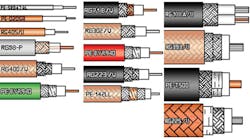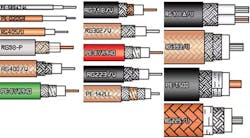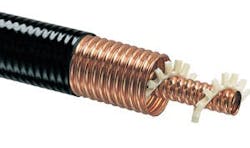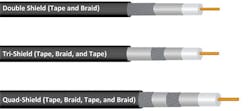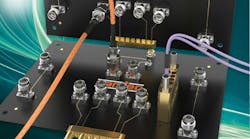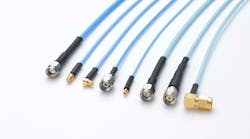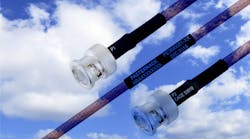This file type includes high resolution graphics and schematics when applicable.
For almost every application, it is challenging to transfer signals from one component to another while maintaining adequate signal integrity. Adding complex and dynamic signal paths requires a flexible platform for adapting to many environments and applications. One solution to this problem was proposed by the renowned engineer and mathematician Oliver Heaviside. He patented a design for a shielded telegraph transmission line in 1880.
In 1929, to overcome the limitations in Heaviside’s design, Bell Labs’ Lloyd Espenschied and Herman Affel developed the broadband coaxial cable with an air-like dielectric spacer. Since this invention, coaxial-cable technologies have advanced in both materials and performance, providing solutions for a wide range of RF/microwave/millimeter-wave interconnection problems.
Basics of Coax-Cable Construction
The most basic version of a coaxial cable is composed of a center conductor, which is mechanically separated from a cylindrically symmetric conducting shield by an air-like dielectric. This cylinder-within-a-cylinder conductor geometry allows electromagnetic (EM) signals below a maximum cutoff frequency to create a transverse-electromagnetic (TEM) wave (or an EM wave with perpendicular magnetic and electric components) within the separation space between the conductors.
For signals beyond the cutoff frequency, the size of the wavelengths are small enough to generate non-perpendicular transverse-electric (TE) and transverse-magnetic (TM) waveguide modes. These additional modes reduce signal integrity and performance. Generally, the larger the diameter of the coaxial cable, the lower the cutoff frequency will be. Power-handling capability also increases with size.
Due to the sensitivity of the TEM mode wave within the coaxial cable, all of the cable’s geometric components must be consistent throughout the transmission line. Otherwise, the signal will suffer from a variety of degrading reflections and phase variations. “An engineer has to think about a cabling assembly as if it’s just another microwave component. Designs often require engineers to spend hundreds and thousands of dollars to get a precision amplifier, filter, or other components with major impact on system performance,” states Steve Ellis, interconnect product manager for Pasternack.
“Cabling has a major impact on system performance when it’s not done right,” Ellis continues. “Some people think of cabling assemblies like PVC piping, as if all cabling does is get a signal from point A to point B. When cabling is chosen or routed without consideration, it’s detrimental to performance. That is why the voltage standing wave ratio (VSWR), insertion loss, phase length, and other performance characteristics are all very critical—and why customers are very demanding when trying to buy high-end cabling products.”
Cabling Materials Are Key to Performance
The materials used to construct coaxial cable may vary, electrically, as a function of vibration, temperature, moisture, current, flexure, and strain. Such variations affect the cable’s performance. Additionally, there is the skin effect—a physical phenomenon that describes the increased distribution of electrons traveling near the surface of a conductor as the frequency of the signal is increased. The skin effect makes the signal traveling along a coaxial cable susceptible to imperfections in conductor surface finish.
As a product of these sensitivities, coaxial-cable designers have developed advanced practices and materials to ensure the highest possible performance while meeting cost, weight, flexibility, loss, and ruggedness needs.
The dielectric spacer within a coaxial cable is critical, as it maintains the coaxial geometries of the two conductors with the added challenge of behaving as much like air as possible. Being air-like involves having close to the same magnetic permeability μ/μ0 and electric permittivity ε/ε0 of air (or an ε and μ of approximately 1, which are both components of the loss tangent δ of the material).
Because very few materials have the same electric and magnetic properties as air, techniques that reduce the amount of disturbing dielectric material used are common. Such techniques include the use of the following: expanded plastic foams with high air content; spiraled dielectric spacers; dielectric ribbons that trap air; and materials designed to be more like air.
To maintain the air-like mechanical and thermal properties of a dielectric, much investment has focused on the chemical material development of plastics. Originally, solid tubes of Teflon were used for the coaxial dielectric, as Teflon is highly electrically stable. It also has high chemical and thermal resistance at low cost. Unfortunately, however, Teflon flows at room temperature. As a result, it has been mostly replaced in low-cost applications by polytetrafluoroethylene (PTFE) foams or nylon materials.
Other materials, such as extruded fluoropolymer resin, offer enhanced performance over PTFE in terms of phase stability and velocity of propagation (VOP). Teflon and nylon dielectrics typically have a phase velocity in the 70% range. In contrast, PTFE-expanded air dielectrics can reach the low-to-mid-80% range, while fluoropolymer resins have been developed with phase velocity in the upper 80% ranges.
The center conductors of a coaxial cable can be made from many conducting materials in various styles, depending on the application. The traditional center conductor is a simple solid copper wire that extends throughout the coaxial cable. To increase the flexibility of the cable by trading off high-frequency performance, a braided or stranded center conductor can be used. Plating metals—like aluminum, steel, silver, or tin—may be used with copper to reduce the weight and cost of the center conductor.
This approach also ensures that good electrical performance is maintained at higher frequencies, as the surface conductor is primarily copper. In some applications, a hollow metal center conductor can be used to decrease weight and cost while increasing flexibility. Yet this solution is specific to high-frequency applications that do not need to channel high power at low frequencies.
This file type includes high resolution graphics and schematics when applicable.
Further Considerations
This file type includes high resolution graphics and schematics when applicable.
Techniques that are similar to those used on the center conductor are applied to the outer conductor to reduce weight and cost. Designers also strive to improve flexibility and reduce environmental strain. Because the outer conductor serves as the return path for the electrical signal, sufficient thickness must be maintained to prevent leakage/interference of the signal path in most applications. However, maintaining adequate thickness for a solid outer conductor increases weight while reducing flexibility. As a result, methods of braiding, stranding, and winding have been developed to offer adequate protection and performance.
For low-cost applications, like cable television, minimal braiding is used to reduce cost, weight, and size. According to Paul Pino, principal electrical engineer for Gore Microwave Cable Products, “Cable manufacturers use a variety of material types, depending upon performance, cost, and manufacturability targets. Center conductors are generally silver-plated copper, though tin-plated copper is also used. Silver-plated, copper-clad aluminum is used in lightweight applications. Coaxial shields can be a variety of materials including formed beryllium copper, silver-plated copper, and metallized polymers.”
Lighter weight and smaller size may be desirable for higher-performing cables. This trend has led to the development of methods that add shielding layers that are either woven, wound, or wrapped.
Such techniques produce disadvantages when it comes to the flexure and mechanical motion performance of the cable. As a result, additional techniques are required to maintain electrical performance under stress. Using a mechanically insulating dielectric layer between the multi-layered shields helps to prevent shielding deformation and wear over time with motion. It also adds to the shielding capability of the layers. (Shielding materials include wound ribbons, woven ribbons, woven wire, and wound strips of conducting tape—often aluminum.)
Additionally, a crush layer—typically comprising wound cylindrical steel—can be used to surround the high-performance cable. It will prevent damage from high pressures and torqueing. “Increasing the density of the dielectric increases its crush resistance,” says Paul Warren, principal design engineer for Gore Microwave Cable Products. “But the performance of the coaxial cable suffers. So the most common practice is to use a stiffer jacket. For example, adding stainless-steel braid over the coaxial shield improves crush resistance while sacrificing weight and flexibility. Armored cable jackets are the most effective, but they are also very heavy and expensive.”
Depending on the environment that the cable will be in, there also are several methods of jacketing a coaxial cable to protect its performance. The standard coating, polyvinyl chloride (PVC), can be made in a variety of thicknesses and colors. Although PVC is relatively chemical and temperature resistant, it cannot withstand mechanical stressors. A woven outer jacket using high-tensile synthetic materials is sometimes used to increase the mechanical performance of a coaxial cable. Such a jacket provides snug pressure in addition to a coating that is resistant to cuts, slices, and abrasions.
“The other thing that really affects cable assemblies—and the reason that there are so many varieties—is mechanical performance,” notes Ellis. “Performance may have to do with the environment in which the cable will operate. For example, a Navy ship has cabling in a radar system running along the outside of the ship with salt fog, extreme temperatures, and vibration stresses. A lot of development goes into having robust and reliable cable in environments that are that extreme.”
To account for such extremes, some companies have developed proprietary materials and cable layers to enhance the performance of the cable under various conditions. Examples can be found in the aerospace, nautical, and military industries.
This file type includes high resolution graphics and schematics when applicable.
